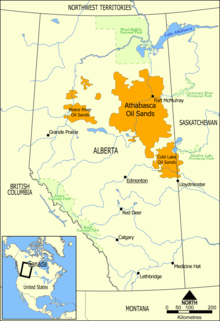அதபசக்கா எண்ணெய் மணல்கள்
| அதபசக்கா எண்ணெய் மணல்கள் | |
|---|---|
 | |
| நாடு | கனடா |
| பிரிவு | வடக்கு ஆல்பெர்ட்டா |
| அக்கரை/இக்கரை | Onshore, mining |
| ஆள்கூறுகள் | 57°01′N 111°39′W / 57.02°N 111.65°W |
| இயக்குபவர்கள் | சின்குரூடு, சன்கார், கனடிய இயற்கை வளங்கள் நிறுவனம் (CNRL), ஷெல், டோட்டல், இம்பீரியல் ஆயில், பெட்ரோ கனடா, டெவோன், அஸ்கி, இசுடாட்யாயில், நெக்சென் |
| பங்குதாரர்கள் | செவ்ரான், மராத்தான், கோனோகோபிலிப்சு, பீ.பி, ஓக்சி |
| வரலாறு | |
| கண்டுபிடிப்பு | 1848 |
| உற்பத்தி ஆரம்பம் | 1967 |
| உற்பத்தி | |
| தற்போதைய எண்ணெய் உற்பத்தி | 13,00,000 bbl/d (~6.5×107 t/a)[1] |
| Estimated oil in place | 1,33,000 Mbbl (~1.81×1010 t)[2] |
| Producing formations | McMurray, Clearwater, Grand Rapids |
அதபசக்கா எண்ணெய் மணல்கள் (Athabasca oil sands) அல்லது அதபசக்கா கரியெண்ணெய் மணல்கள் (Athabasca tar sands) அல்லது ஆல்பர்ட்டா கரியெண்ணெய் மணல்கள் (Alberta tar sands) கனடிய ஆல்பர்ட்டா மாநிலத்தின் வடகிழக்கே மெக்மர்ரி கோட்டையை மையமாகக் கொண்டுள்ள பெரும் அசுபால்ட்டு வைப்புக்கள் அல்லது மிகவும் கனமான பாறை எண்ணெய் வைப்புக்களாகும்.
இந்த எண்ணெய் மணல்கள், முதன்மையாக மெக்மர்ரி படுகையில் அமைந்துள்ளன; இவற்றில் நிலக்கீலுடன் (பகுதி திண்மையான, பாறை வடிவில் பாறையெண்ணெய்) சிலிக்கா மணல், களிமண் தாதுக்கள், நீர் கலந்துள்ளன.உலகில் அறியப்பட்டுள்ள நிலக்கீல் வைப்புக்களில் அதபசக்கா எண்ணெய் மணல்களே மிகப் பெரியனவாகும். ஆல்பர்ட்டாவில் அமைந்துள்ள மூன்று எண்ணெய்மணல்வெளிகளில் இதுவே பெரியதாகும். மற்றவை அமைதியாற்று எண்ணெய் மணல்களும் கோல்டுலேக் எண்ணெய் மணல்களும் ஆகும். இதில் கோல்டுலேக்கு எண்ணெய் மணல்கள் சஸ்காச்சுவான் வரை பரந்துள்ளன.[3]
இவை அனைத்தும் 141,000 சதுர கிலோமீட்டர்கள் (54,000 sq mi) பரப்பளவு சேறு மற்றும் தைகா காடுகளில் உள்ளன; இவற்றில் 1.7 trillion barrels (270×109 m3) நிலக்கீல் உள்ளது. உலகில் வழமையான பாறை எண்ணெய் வைப்புக்களுக்கு இணையாக இது உள்ளது. பன்னாட்டு ஆற்றல் முகமை (IEA) பொருளியல்ரீதியாக மீட்கக்கூடிய வைப்புக்களைப் பட்டியலிட்டுள்ளது; 2006இல் இது 178 billion barrels (28.3×109 m3) அளவில், ஏறத்தாழ மொத்த வைப்புக்களில் 10% ஆக இருந்தது.[3] கனடாவின் உறுதியளிக்கப்பட்ட மொத்த வைப்புக்கள் உலகில் மூன்றாவது மிகப்பெரிய நிலையில் உள்ளது; சவூதி அரேபியா மற்றும் வெனிசூலாவின் ஓரினோக்கோ மண்டலம் மற்றவிரு வைப்புகளாகும்.[4]
இருவிதமான பிரித்தெடுக்கும் நுட்பங்கள் பயன்படுத்தப்படுகின்றன: தரைமட்டத்திற்கு அடியில் ஆழமாக இருக்கும் நிலக்கீலை பிரித்தெடுக்க இயல் நிலை பிரித்தெடுப்பு பயன்படுத்தப்படுகின்றது; தரைமட்டத்திற்கு அருகிலுள்ள நிலக்கீலைப் பிரித்தெடுக்க திறந்தவெளி அல்லது தரைமட்ட சுரங்க முறை பயன்படுத்தப்படுகின்றது. இரண்டாவது வகையில் 20%தான் பிரித்தெடுக்க முடியும்.[5] மேலும் இது நச்சுநிறை குளங்களை உண்டாக்குகின்றது. மாறாக இயல்நிலை பிரித்தெடுப்பில் சிறப்பு வழிமுறைகள் பயன்படுத்தப்படுவதால் புவிமாசடைதல் குறைவாக உள்ளது. ஆல்பெர்ட்டாவில் 97.5% பகுதியில் இயல்நிலை பிரித்தெடுப்பே நடைபெறுகின்றது.[6]
பெரியளவு சுரங்க வேலைகளால் சுற்றுச்சூழலுக்கும் உடல்நலத்திற்கும் ஏற்படும் கேடுகளை குறைப்பதற்கு அரசும் இத்தொழிலில் ஈடுபட்டுள்ள நிறுவனங்களும் மேற்கொள்ளும் நடவடிக்கைகள் போதுமானதாக இல்லை என தன்னார்வலர்கள் எதிர்த்து வருகின்றனர்.[7][8] இரு தரப்பும் வைக்கும் ஒருசார்பான தரவுகளால் புறநிலைக் கருத்து எதுவும் எய்தவியலவில்லை.[9][10][11]

மேற்சான்றுகள்
[தொகு]- ↑ IHS CERA (மே 18, 2009). "Oil Sands Move from the 'Fringe to Center' of Energy Supply". RigZone. Archived from the original on 2009-05-21. Retrieved 2009-05-19.
- ↑ "காப்பகப்படுத்தப்பட்ட நகல்" (PDF). Archived from the original (PDF) on 2012-09-25. Retrieved 2017-03-01.
- ↑ 3.0 3.1 Mather, Clive யூடியூபில் "The Oil Sands of Alberta", Canada Broadcasting Corporation.
- ↑ "Alberta's Oil Sands 2006" (PDF). Government of Alberta. 2007. Archived from the original (PDF) on 2008-02-27. Retrieved 2008-02-17.
- ↑ "Steam-Assisted Gravity Drainage (SAGD)". Cenovus. Archived from the original on 2016-04-26. Retrieved 2016-05-07.On this site is a Cenovus animation on how SAGD works.
- ↑ "What are Oil Sands?". CAPP. 2009. Archived from the original on 2013-05-25. Retrieved 2016-05-07.
- ↑ "Alberta Plan Fails to Protect Athabasca River". Archived from the original on 2007-04-26. Retrieved 2016-05-07.
- ↑ "Alberta's tar sands are soaking up too much water". The Globe and Mail (Dogwood Initiative). 2006-07-05. http://www.dogwoodinitiative.org/newsstories/oilandwaterdonotmix. பார்த்த நாள்: 2016-05-07.
- ↑ "'Conspiracy of silence' on tarsands, group says". CTV News இம் மூலத்தில் இருந்து 2008-02-20 அன்று. பரணிடப்பட்டது.. https://web.archive.org/web/20080220054616/http://www.ctv.ca/servlet/ArticleNews/story/CTVNews/20080215/tarsands_enviroreport_080215/20080215?hub=SciTech. பார்த்த நாள்: 2008-02-16.
- ↑ "Tar won't stick". Edmonton Journal. http://www.canada.com/edmontonjournal/news/opinion/story.html?id=09dd2691-c993-44a3-a254-26619a230a80. பார்த்த நாள்: 2008-02-16.
- ↑ "Time for Ottawa to stop tiptoeing around Alberta oilsands sensibilities". Oil Week. 2008-02-15 இம் மூலத்தில் இருந்து 2008-06-03 அன்று. பரணிடப்பட்டது.. https://web.archive.org/web/20080603062838/http://www.oilweek.com/news.asp?ID=14357. பார்த்த நாள்: 2008-02-16. (industry publication)
மேலும் அறிய
[தொகு]- Robert Kunzig (March 2009). "The Canadian Oil Boom: Scraping Bottom". National Geographic 215 (3): 38–59. http://ngm.nationalgeographic.com/2009/03/canadian-oil-sands/kunzig-text. பார்த்த நாள்: 29 May 2009.
- Black Bonanza, by Alastair Sweeny (Wiley Canada 2010) பன்னாட்டுத் தரப்புத்தக எண் 0-470-16138-8
ஒளிதங்கள்
[தொகு]- ted talk 2012 Garth Lenz: The true cost of oil
- Dirty Oil. Documentary by Leslie Iwerks, 2009
- H2Oil. Documentary by Shannon Walsh, 2009
- Tar Sands – Canada for Sale Documentary by Tom Radford, 2008
- People & Power – Alberta's Oil Sands. Al Jazeera English, 2008 (யூடியூபில் online copy)
- Riz Khan – Canada's dirty oil. Al Jazeera English, 2009 (online copy யூடியூபில் part 1, யூடியூபில் part 2)
- 60 Minutes – The Alberta Oil Sands. CBS, 22. January 2006
- To the Last Drop (யூடியூபில் part 1, யூடியூபில் part 2). Documentary by Tom Radford about the impact on local communities, broadcast on Al Jazeera English's program Witness, 2011
- The Alberta Oil Sands. Govt. of Alberta Documentary Film ([1]), 2009
வெளி இணைப்புகள்
[தொகு]- Pembina Institute: Oil Sands Analysis பரணிடப்பட்டது 2012-01-20 at the வந்தவழி இயந்திரம்
- Alberta’s Oil Sands: Key Issues and Impacts
- Mud, Sweat and Tears—Guardian Newspaper, 2007
- Hugh McCullum, Fuelling Fortress America: A Report on the Athabasca Tar Sands and U.S. Demands for Canada's Energy (The Parkland Institute)

